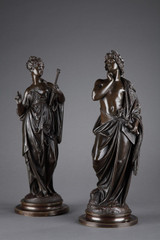A very fine pair of bronze statuettes with a brown patina, depicting two figures in the style of antiquity: the poet and his muse. The adolescent, with a pensive face framed by curls and crowned with a laurel wreath, wears a pleated toga edged with a purple band. Bare-chested, his face turned to the left, he holds a scroll of parchment in one hand while lightly touching his chin with the other. His meditative gaze alludes to his art: lyric poetry. In antiquity, this was the expression of the poet's personal feelings, as he sang of his emotions, aspirations, joys, and sorrows. His counterpart is a draped woman, her hair gathered in a chignon and adorned with a diadem, holding in her left arm the lyre, a musical instrument that originally accompanied sung poetry. This is Erato, the muse of lyric poetry, one of the nine muses in Apollo's retinue, depicted in Raphael's "Parnassus" (1509-1511). In ancient Greece, the muses presided over poetic inspiration and all intellectual pursuits. Apollo, god of music, led their choir. The subject of artistic creation and inspiration enjoyed enormous popularity during the Italian Renaissance, as well as in 17th-century France, with Poussin's famous example: "The Inspiration of the Poet" (1629-1630). Each bronze rests on a circular base and a stepped plinth. 19th century, circa 1830. Dimensions: W: 11.5 cm, D: 11.5 cm, H: 33 cm.
- Reference :
- 1469
- Availability :
- Sold
- Width :
- 12 (cm)
- Height :
- 33 (cm)
- Depth :
- 12 (cm)
- Identify Exists:
- False
















